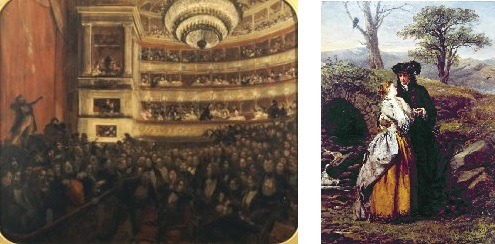The origins of melodramma
The origins of melodramma
The origins of melodrama
The musical theatre has always taken inspiration from highly worthy literary sources. One of the first operas in history – Monteverdi’s Orfeo- was evidently influenced by the Renaissance poet, Angelo Poliziano. Other great masterpieces, written in the Baroque period by men such as Vivaldi or handle, draw their inspiration from the epic poems of Ariosto and Tasso.

Masks and comedies
The comic musical tradition was transformed thanks to Carlo Goldoni, who was not only a great playwright but also a significant librettist. He successfully re-defined the new nature of the opera buffa which was to blossom into masterpieces such as Le Nozze di Figaro and Il barbiere di Siviglia, both taken from comedies by Beaumarchais. Carlo Gozzi, on the other hand, more sensitive to the tradition of the commedia dell’arte, acted as an alternative to Goldoni, with works such as Turandot and L’amore delle tre melarance, which enjoyed re-found fortune in the twentieth century.

The middle age british style
Early romanticist literature tended to norture a Medieval age of fantasy made up of melancholic landscapes, Gothic architecture, ruined towers and castles, as can be found in the pages of early nineteenth- century British writers like sir Walter Scott, with his Lady of the Lake, The Bride of Lammermoor and Kenilworth, which became sources for Rossini and Donizzetti. Two works of Verdi’s “years in prison” were inspired by Lord Byron: I due Foscari and Il Corsaro.

Hugo’s battle
The controversy between classicists and romanticists provoked by Victor Hugo’s Hernani in 1830 mirrored the radical change in sensitivities during the nineteenth century. Hugo’s dramas became the model for a new type of melodrama: in operas such as Donizetti’s Lucrezia Borgia, Verdi’s Ernani and Rigoletto, even Ponchielli’s Gioconda, there is a greater degree of movement in the action and passages bordering on the grotesque.

German drama and italian opera
In the wake of the diffusion of Madame de Staël’s work De l’Allemagne in Italian intellectual circles, authors such as Goethe and Schiller became the sources of a new musical theatre. Some of Verdi’s operas- I Masnaderi, Giovanna D’arco, Luisa Miller, Don Carlo– were taken from Schiller. The European vocation of the writer and composer, Arrigo Boito, was to become a truly artistic mission when he took Goethe’s Faust as the inspiration for his Mefistofele.

Verdi’s Shakespeare
Still today Shakespeare’s comedies and tragedies are among the most important literary sources for the musical theatre. It was in the nineteenth that Shakespeare’s work met with his fortune, thanks to Andrea Maffei’s translations into Italian, upon which Verdi based his Macbeth. In his later years, Verdi was to return to English poet for his last operas, Otello e Falstaff: the result was extraordinary dramatic effect and sophisticated solutions.

A theatre of actresses
Certain interpretations of realist dramas influenced the choice of a subject for an opera. Particularly actresses such as Sarah Bernhardt or Eleonora Duse often attracted the composers’ attention. It was only after he had seen Bernhardt in La Tosca that Puccini decided to base an opera on Victorien Sardou’s play. And the same thing happened after the composer had seen two works by David Belsaco – Madame Butterly in London and The Girl of the Golden West in New York.

D’Annunzio, a european author
Between the late nineteenth and early twentieth centuries, prestigious literary sources were increasingly adopted as a subjects for operas. Gabriele D’Annunzio was without a doubt the foremost Italian writer of the day and, from a musical point of view, his influence left its mark on composers such as Mascagni, Zandonai, Malipiero, not to mention Honegger and Debussy, and continued to do so after the Secon World War. Indeed, Pizzetti composed La figlia di Iorio in 1954.

